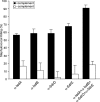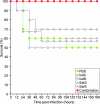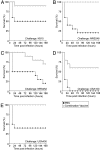Vaccine assembly from surface proteins of Staphylococcus aureus
- PMID: 17075065
- PMCID: PMC1636558
- DOI: 10.1073/pnas.0606863103
Vaccine assembly from surface proteins of Staphylococcus aureus
Abstract
Staphylococcus aureus is the most common cause of hospital-acquired infection. Because of the emergence of antibiotic-resistant strains, these infections represent a serious public health threat. To develop a broadly protective vaccine, we tested cell wall-anchored surface proteins of S. aureus as antigens in a murine model of abscess formation. Immunization with four antigens (IsdA, IsdB, SdrD, and SdrE) generated significant protective immunity that correlated with the induction of opsonophagocytic antibodies. When assembled into a combined vaccine, the four surface proteins afforded high levels of protection against invasive disease or lethal challenge with human clinical S. aureus isolates.
Conflict of interest statement
The authors declare no conflict of interest.
Figures




References
-
- Diekema DJ, Pfaller MA, Schmitz FJ, Smayevsky J, Bell J, Jones RN, Beach M. Clin Infect Dis. 2001;32:S114–S132. - PubMed
-
- Lowy FD. N Engl J Med. 1998;339:520–532. - PubMed
-
- Archer GL, Climo MW. N Engl J Med. 2001;344:55–56. - PubMed
-
- Kaplan SL, Hulten KG, Gonzalez BE, Hammerman WA, Lamberth L, Versalovic J, Mason EOJ. Clin Infect Dis. 2005;40:1785–1791. - PubMed
-
- Weigel LM, Clewell DB, Gill SR, Clark NC, McDougal LK, Flannagan SE, Kolonay JF, Shetty J, Killgore GE, Tenover FC. Science. 2003;302:1569–1571. - PubMed
Publication types
MeSH terms
Substances
Grants and funding
LinkOut - more resources
Full Text Sources
Other Literature Sources

